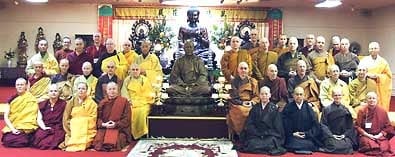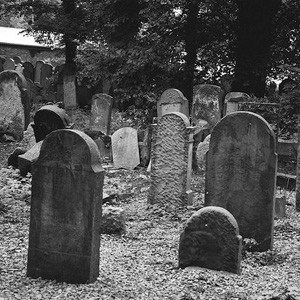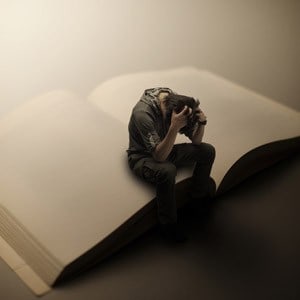Monastic health

Report on the 13th annual gathering of Western Buddhist monastics, held at City of the Dharma Realm in West Sacramento, California, from April 9-13, 2007.
I’ve had the joy of attending all but two of these conferences in the past. Imagine: in the time when religion is so often used to create disharmony, 40 Buddhist monastics (mostly Westerners and some Asians; even balance of women and men) meet harmoniously for five days to discuss topics relevant to monastic life and the spread of the Dharma in our countries. We come from a variety of different Buddhist traditions—Thai and Sri Lankan Theravada; Vietnamese, Chinese, Japanese, and Korean Ch’an and Pure Land; and various traditions within Tibetan Buddhism. Each year a different monastery hosts the event; this year it was at the City of the Dharma Realm, a Chinese monastery with a resident community of about 20 nuns in Sacramento.
The daily schedule was full with meditation and chanting morning and late afternoon, sessions in the morning, afternoon, and evening, and spare time to talk and deepen friendships that have formed over the years of our attending this gathering. The main meal offering was formal, eaten in silence with beautiful Chinese chanting before and afterwards (most of us caught on by the end of the week, although our Chinese pronunciation left a lot to be desired!).
The theme was “Health” and Ven. Lobsang Jinpa, a monk who is an Ayurvedic doctor, began our exploration with an overview of Ayurveda. This was followed by a session in which we chanted the “Sutra on Impermanence” and discussed various liturgy used for healing. Later in the conference I led a meditation on White Tara, a Buddhist deity whose practice promotes long life so that we can practice the Dharma for as long as possible. Theravada monks taught us how to chant several parritas, short sutras that the Buddha wrote as blessings, for healing from illness as well as from grief.
The next day we talked about health insurance, for most monastics are uninsured or underinsured. One woman had heard of this situation and offered to investigate the situation for us. It would indeed be wonderful if we could have group policy as monastics, but health insurance being what it is in the US, we are not overly optimistic. Another session focused on the topic of elder care. How can we help monastics when they are no longer able to be active in the monastery schedule and require full-time care? What will happen to monastics who live on their own when they become old? These are complex questions.
When we are ill, injured, or old, our real refuge is the Dharma, and thus three monastics—Bhikkhu Bodhi, Ven. Lodro Dawa, and Rev. Phoebe—shared with us how they used the Dharma to deal with extreme pain, injury, and loss of sight. This discussion was very moving, honest, and raw. We talked about the challenge of accepting and transforming the limitations physical problems place on our Dharma practice. The mind that rejects the situation makes it even more difficult, and while we try to practice mindfulness of sensation or the taking and giving meditation, the very human mind sometimes says, “I want this to go away ASAP!” Rev. Phoebe inspired us all when she said that she is glad about her physical difficulties, “It has made my Dharma practice stronger. Also, I realized that while part of my body did not function well, the rest of my body was fine, so I determined to make use of this opportunity.” When we experience misery, our compassion increases, as does our renunciation of cyclic existence. The kindness of others becomes more apparent and we do not take our good conditions for granted. All of these help us to transform our mind.
Ven. Drimay did a presentation on how the body is viewed in different meditation practices. In the first, we meditate on the parts of the body in order to see its unattractiveness and thus to reduce lust and attachment. In the Chod practice, we imagine transforming and offering our body to malevolent spirits. Finally, in Tantra, we imagine dissolving into emptiness and appearing with the body of a deity. There was much more to say on this topic and her presentation sparked us to further contemplation.
Some sessions were relaxed—the group gathered in the monastery lounge to discuss storytelling and Buddhist songs and to see slides of Gampo Abbey. I gave an update on the topic of bhikshuni ordination, and the fifteen bhikshunis at the conference did Posadha (picture above)—confession and restoration of vows—together. The latter was especially moving. At the conclusion of Posadha, one of the junior bhikshunis asked the Mahatheris, those who had been bhikshunis for twenty years or longer, to sit in front. She led the juniors in offering their respects and then requested Dharma advice from the five seniors. Here we were in the West, establishing the bhikshuni sangha and following the centuries-old custom of seniors guiding juniors in the Dharma and juniors honoring seniors.
Over the years of our meeting, our friendships have deepened. Not only have we learned about each other’s traditions, teachings, and practices, but we have taken some of them back with us to our own monasteries. When we face challenges, we know there is a larger community of monastic sangha to whom we can turn for support. All of us seek to preserve the Dharma in our mind and hearts and in our world. One way we do this is by living in monastic precepts and living a monastic lifestyle. In our consumerist and materialist world, this treasure of the sangha is precious.
Venerable Thubten Chodron
Venerable Chodron emphasizes the practical application of Buddha’s teachings in our daily lives and is especially skilled at explaining them in ways easily understood and practiced by Westerners. She is well known for her warm, humorous, and lucid teachings. She was ordained as a Buddhist nun in 1977 by Kyabje Ling Rinpoche in Dharamsala, India, and in 1986 she received bhikshuni (full) ordination in Taiwan. Read her full bio.


